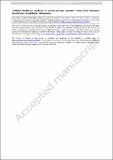| dc.contributor.author | Ward, Thomas M. | |
| dc.contributor.author | Hashimoto, Daniel A. | |
| dc.contributor.author | Ban, Yutong | |
| dc.contributor.author | Rosman, Guy | |
| dc.contributor.author | Meireles, Ozanan R. | |
| dc.date.accessioned | 2022-08-25T12:48:17Z | |
| dc.date.available | 2022-08-25T12:48:17Z | |
| dc.date.issued | 2022-01-14 | |
| dc.identifier.uri | https://hdl.handle.net/1721.1/144433 | |
| dc.description.abstract | Abstract
Background
Operative courses of laparoscopic cholecystectomies vary widely due to differing pathologies. Efforts to assess intra-operative difficulty include the Parkland grading scale (PGS), which scores inflammation from the initial view of the gallbladder on a 1–5 scale. We investigated the impact of PGS on intra-operative outcomes, including laparoscopic duration, attainment of the critical view of safety (CVS), and gallbladder injury. We additionally trained an artificial intelligence (AI) model to identify PGS.
Methods
One surgeon labeled surgical phases, PGS, CVS attainment, and gallbladder injury in 200 cholecystectomy videos. We used multilevel Bayesian regression models to analyze the PGS’s effect on intra-operative outcomes. We trained AI models to identify PGS from an initial view of the gallbladder and compared model performance to annotations by a second surgeon.
Results
Slightly inflamed gallbladders (PGS-2) minimally increased duration, adding 2.7 [95% compatibility interval (CI) 0.3–7.0] minutes to an operation. This contrasted with maximally inflamed gallbladders (PGS-5), where on average 16.9 (95% CI 4.4–33.9) minutes were added, with 31.3 (95% CI 8.0–67.5) minutes added for the most affected surgeon. Inadvertent gallbladder injury occurred in 25% of cases, with a minimal increase in gallbladder injury observed with added inflammation. However, up to a 28% (95% CI − 2, 63) increase in probability of a gallbladder hole during PGS-5 cases was observed for some surgeons. Inflammation had no substantial effect on whether or not a surgeon attained the CVS. An AI model could reliably (Krippendorff’s α = 0.71, 95% CI 0.65–0.77) quantify inflammation when compared to a second surgeon (α = 0.82, 95% CI 0.75–0.87).
Conclusions
An AI model can identify the degree of gallbladder inflammation, which is predictive of cholecystectomy intra-operative course. This automated assessment could be useful for operating room workflow optimization and for targeted per-surgeon and per-resident feedback to accelerate acquisition of operative skills.
Graphical abstract | en_US |
| dc.publisher | Springer US | en_US |
| dc.relation.isversionof | https://doi.org/10.1007/s00464-022-09009-z | en_US |
| dc.rights | Article is made available in accordance with the publisher's policy and may be subject to US copyright law. Please refer to the publisher's site for terms of use. | en_US |
| dc.source | Springer US | en_US |
| dc.title | Artificial intelligence prediction of cholecystectomy operative course from automated identification of gallbladder inflammation | en_US |
| dc.type | Article | en_US |
| dc.identifier.citation | Ward, Thomas M., Hashimoto, Daniel A., Ban, Yutong, Rosman, Guy and Meireles, Ozanan R. 2022. "Artificial intelligence prediction of cholecystectomy operative course from automated identification of gallbladder inflammation." | |
| dc.contributor.department | Massachusetts Institute of Technology. Department of Electrical Engineering and Computer Science | |
| dc.contributor.department | Massachusetts Institute of Technology. Computer Science and Artificial Intelligence Laboratory | |
| dc.eprint.version | Author's final manuscript | en_US |
| dc.type.uri | http://purl.org/eprint/type/JournalArticle | en_US |
| eprint.status | http://purl.org/eprint/status/PeerReviewed | en_US |
| dc.date.updated | 2022-08-25T03:28:19Z | |
| dc.language.rfc3066 | en | |
| dc.rights.holder | The Author(s), under exclusive licence to Springer Science+Business Media, LLC, part of Springer Nature | |
| dspace.embargo.terms | Y | |
| dspace.date.submission | 2022-08-25T03:28:19Z | |
| mit.license | PUBLISHER_POLICY | |
| mit.metadata.status | Authority Work and Publication Information Needed | en_US |
